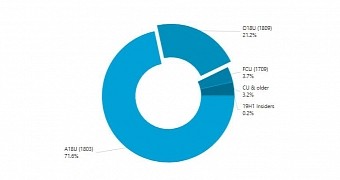Windows 10 October 2018 Update is slowly turning out to be Microsoft’s biggest failure on Windows 10 so far, as its adoption remains super-slow, according to third-party data.
The October update, also known as version 1809, was shipped by Microsoft on October 2, 2018, but got pulled only a few days later due to a major bug causing the removal of user files stored in libraries.
The update was re-released in November, and since then, Microsoft gradually pushed it to compatible devices across the world, but obviously with a more cautious approach following the original launch fiasco.
All the issues that were discovered in the October update apparently affected its adoption significantly, as AdDuplex data shows the latest Windows 10 version remains well behind its predecessor, even so many months after its release.
New update coming in a couple of months
At this point, the April 2018 Update, also referred to as version 1803, is currently the leading Windows 10 version with a share of 71.6%, followed by the October update with 21.2%.
“While this number is almost double of what we've seen last month, it's still far away from the dominating April 2018 Update,” AdDuplex says.
“With only a few months to go until the next Windows 10 update is supposed to go mainstream, it is unclear if some PCs may have to install two major updates within a short period of time or go straight from A18U to 19H1.”
The good news is that most users upgraded from the Fall Creators Update, which currently has a share of 3.7%, and no less than 0.2% of the users are already on 19H1 preview builds. Only 3.2% of the users run the Creators Update or the previous Windows 10 versions which no longer receive updates on Home and Pro SKUs.
The April 2019 Update is projected to be finalized next month, and the public rollout to production devices should kick off in April.

 14 DAY TRIAL //
14 DAY TRIAL //